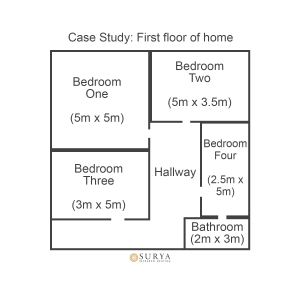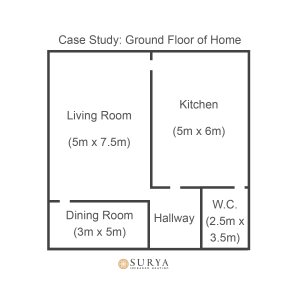As many people don’t know too much about infrared heating as a concept, they don’t realise how much they can save you. They’re not just electric heaters; they’re efficient heaters that can lead to plenty of savings.

Infrared heaters, of course, heat your room in a much different way to traditional heaters. By heating the objects, rather than the air around the room, you can save lots of energy – and in turn, plenty of money.
In fact, by switching from conventional radiators to infrared heaters, you could save around 60% on your heating bills!
We’re going to have a go at seeing how much energy and money you can save on heating your house via an infrared heater, an electric space heater, and conventional central heating. Check out these two floors of a home to see the amount of power you’d need.

First Floor Plan

Ground Floor Plan
Working out the Heat You’ll Need
To work out the required wattage of IR heaters, you just have to do a couple of simple calculations. All you have to do is work out the volume of your room in m3, which is done by multiplying the height, width, and length of your room. You then have to see how many watts are required per m3. This table shows how many watts are required per level of insulation.

You then just need to multiply the volume by the suggested amount of watts, and you’ll have the total wattage requirement for this room.
The Maths
It’s time to do the maths for our case study rooms. On the ground floor, we have the following measurements. For the sake of this walkthrough, we’re going to assume that our house has moderate insulation, and will therefore require 25W per square metre.


It’s now time to see which heaters we’ll need for each room. In the living room, which needs 2250W, two 1200W heaters will be plenty. The dining room needs 900W, so the 900W heater is perfect. The kitchen will need two 900W heaters to suit its 1800W needs. The bathroom requires 525W, so a 580W heater will be enough.
Upstairs, bedroom one will need 1500W, so a 1200W and a 350W will be enough. Bedroom two requires 1050W, so you could use two 580W heaters. In bedroom three, you’ll need 900W, for which a 900W heater would be perfect. Bedroom four requires 750W, so a 900W heater would do nicely. The bathroom would need 360W, so a 350W would just about do.
In total, to heat this home, we’d need approximately 10,540W of energy.
Comparisons Between Heaters
To make comparisons between the heaters, we need to work out how much power we’d need. To heat this house using electric space heaters, you’d need approximately 43,000 watts of energy! For central heating, it’s a little less, but still approximately 25,000W!
The next thing to do is to work out exactly how much your energy costs. At the time of writing, the average price of electricity is about 12.5p per kWh, and gas prices are around 3p per kWh.
kWh is basically the amount of kilowatts (1000 watts) being used for one hour. So if you had a 200W television being used for ten hours, it would be 2kWh. That’s because 200W times ten hours = 2000. 2000 divided by 1000 = 2kWh.
Imagine that you use your heating for around 150 hours per month – this is five hours a day for thirty days. That means that to heat your house for 150 hours a month with infrared heaters, you’d multiply 10,540 by 150, and then divide it by 1,000. This equals around 1,581kWh.
For electric space heaters, it would be 43,000W multiplied by 150 and then divided by 1,000. This gives a result of 6,450kWh. Central heating gives an answer of around 3750 kWh.
Finally, you need to work out how much it costs, by multiplying the cost of kWh by the amount of kWh. For infrared heating it is £197.63, electric space heaters cost £806.25, and central heating costs around £112.50. This means that to heat your whole home, it appears that central heating would be the cheapest option for your home, thanks to the low price of gas vs. electricity. So why, as a supplier of infrared heaters, would we be telling you this? Well, that’s because infrared heaters can be much cheaper than central heating, still.

The Flexibility of Infrared Heating
Here are a few reasons as to why infrared heaters can still be cheaper than central heating. With central heating, you will forever be heating the whole house. This means that every time you have the heating on for an hour, you’ll be using 25kWh, or 75p worth of energy. With infrared heating, however, you won’t have to heat the whole house. Imagine the family are all sat downstairs in the living room. Why would you need the bathroom or kitchen warming? We’ve established the living room had two 1200W heaters, so for an hour, they’d use just 2.4kWh, or just 30p.
If it was just you at home, relaxing in the master bedroom, then you’d have just 1.5kWh of energy, or around 19p of electricity. It’s clear that although gas is much cheaper than electricity, the energy-efficiency and flexibility of infrared heating makes it a much cheaper proposition.

That’s not all, either. Because of the penetrative nature of infrared heat, you don’t actually have to have the heating on as long. It penetrates your body by around three inches, meaning you don’t have to worry about you not feeling the warmth. It heats objects, not the air, meaning that heat is retained for longer, and shared about more freely. With central heating, if you wish to feel the warmth of 21˚C, you need to heat the room to 23˚C. Infrared heating would need to heat the room to 21˚C.
Another bonus to infrared heating is how quickly the room is heated up. Central heating can often take around 30 minutes before you start to feel the positive effects. With infrared heating, it’s normally less than ten minutes. This means that you’ll need the heating on for less time than central heating.
The Choice is Yours
Remember, this is purely based on the monetary cost of infrared heating. It uses less energy, is better for the environment, and has quite a few health benefits over conventional heating. It looks fantastic in your home, and it can be smart, too – just look at our NXTGEN panels!
If there’s anything else you need to know about infrared heating, then don’t be afraid to get in touch. . Call us on 0116 321 4124, email us at sales@suryaheating.co.uk, or check out our Facebook, Instagram and Twitter.






 Accepted Here
Accepted Here